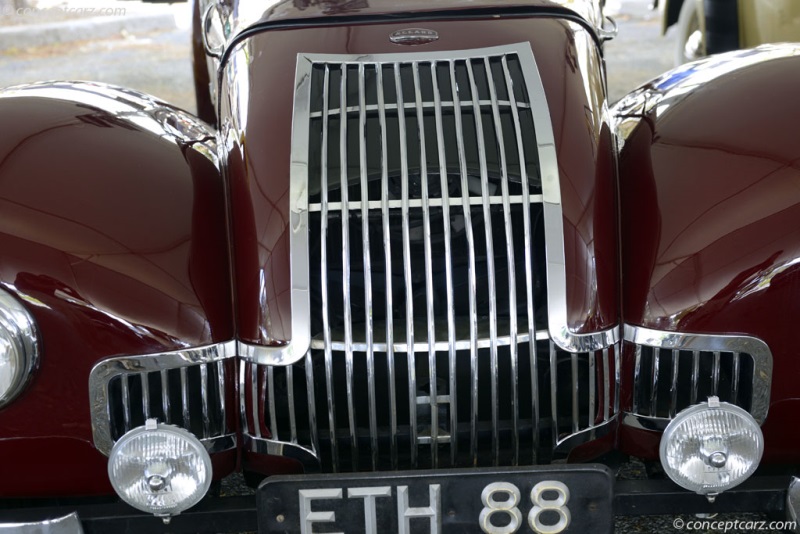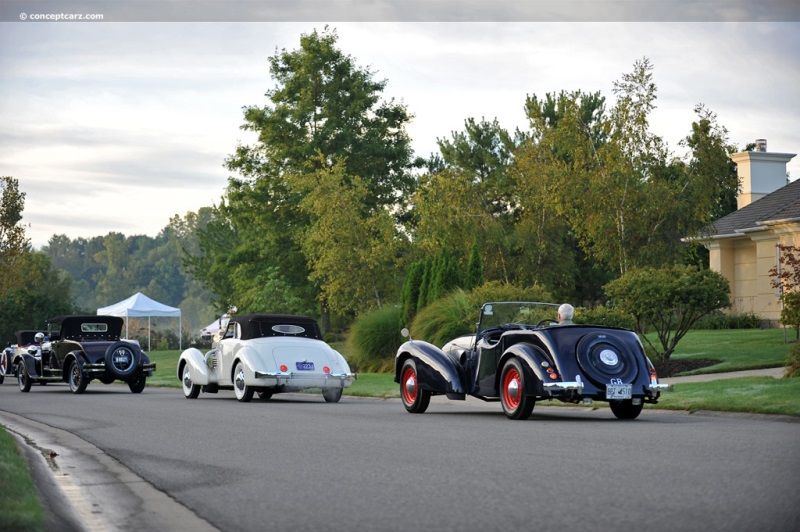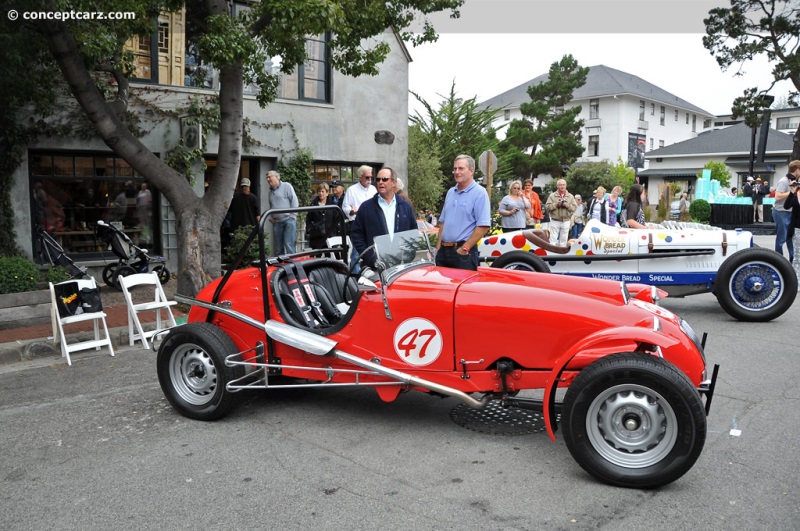Sydney Allard was a talented car constructor and racing driver who, in the 1930s, built several Ford-based racing specials with some receiving power from Lincoln engines and many using a split-axle independent front suspension developed by Leslie Ballamy. During World War II, his London garage, which went by the confusing name Adlards, Ltd., rebuilt Ford vehicles for British forces. When peacetime resumed, Sydney Allard seized upon even larger American engines installed in his own chassis with deDion rear suspension and a split Ford beam front axle with coil springs and radius rods.
In the immediate post-war era, the public was eager to resume a normal life. Since automobile production had ceased in the early 1940s to support the war efforts, automobile manufacturers struggled to keep pace with demand. Most used pre-war designs with mildly updated styling.
Mr. Allard's early postwar sports cars were both brutal and beautiful, with their elemental bodies and potent American overhead-valve V-8 engines. The later J2 and J2X models of the early 1950s were attempts at making road-going cars more 'civilized' while retaining their visceral performance. The models that preceded the J2/J2X included the Allard K1 which had been introduced in 1946. With an abundance of engines and parts and no government contracts, Allard designed a two-seater on a box-section frame with transverse leaf springs and an independent front setup inspired by Leslie Bellamy. Power was supplied by either Ford or Mercury flathead V8 engines. A longer wheelbase version, called the L-Type, had seating for four occupants and continued in production through February of 1950, with most being built prior to 1949.
In 1947, Allard introduced the J1, K1, and M1. The K1 had a shortened chassis and was intended for sprints and trials. The M1 was larger with seating for four.
The Allard L-Type used a six-inch longer chassis than the contemporary K-Type and employed Allard's trademark independently suspended 'split' front axle and transverse-leaf rear end. As with the majority of Allards products, the L-Type used Ford and Mercury components with engines being the 221 cubic-inch Ford or 239 CID Mercury V8. Most of the L-Types received coachwork from the Hilton Brothers' workshop in Fulham. There, they received ash-framed, hand-crafted bodies with a fully carpeted interior with leather-trimmed seats, a fold-flat windscreen, and a removable hood and side screens.
Between 1946 and 1950, Allard built a total of 191 examples of the L-Type.
by Daniel Vaughan | Jul 2020
In the immediate post-war era, the public was eager to resume a normal life. Since automobile production had ceased in the early 1940s to support the war efforts, automobile manufacturers struggled to keep pace with demand. Most used pre-war designs with mildly updated styling.
Mr. Allard's early postwar sports cars were both brutal and beautiful, with their elemental bodies and potent American overhead-valve V-8 engines. The later J2 and J2X models of the early 1950s were attempts at making road-going cars more 'civilized' while retaining their visceral performance. The models that preceded the J2/J2X included the Allard K1 which had been introduced in 1946. With an abundance of engines and parts and no government contracts, Allard designed a two-seater on a box-section frame with transverse leaf springs and an independent front setup inspired by Leslie Bellamy. Power was supplied by either Ford or Mercury flathead V8 engines. A longer wheelbase version, called the L-Type, had seating for four occupants and continued in production through February of 1950, with most being built prior to 1949.
In 1947, Allard introduced the J1, K1, and M1. The K1 had a shortened chassis and was intended for sprints and trials. The M1 was larger with seating for four.
The Allard L-Type used a six-inch longer chassis than the contemporary K-Type and employed Allard's trademark independently suspended 'split' front axle and transverse-leaf rear end. As with the majority of Allards products, the L-Type used Ford and Mercury components with engines being the 221 cubic-inch Ford or 239 CID Mercury V8. Most of the L-Types received coachwork from the Hilton Brothers' workshop in Fulham. There, they received ash-framed, hand-crafted bodies with a fully carpeted interior with leather-trimmed seats, a fold-flat windscreen, and a removable hood and side screens.
Between 1946 and 1950, Allard built a total of 191 examples of the L-Type.
by Daniel Vaughan | Jul 2020
Related Reading : Allard L-Type History
The new Allard, said The Autocar in February 1946, has changed its sporting tweeds for a lounge suit. There were other changes. Allards were no longer specials, for their builders had taken on a new identity. The Allard Motor Company, formed in 1945, now operated from a kind of factory in South Hill Park, Clapham, and a whole collection of workshops around South and West London. On the strength....
Continue Reading >>
Continue Reading >>
Related Reading : Allard L-Type History
During the 1940s and 1950s, the name Allard was a highly esteemed motor manufacturer. Some of the worlds most influential people were the proud owners of an Allard automobile including Carroll Shelby, Clark Gable, Richard Dimberley, John Fitch, Jack Fairman and Frank Curtis. On the racetrack, racing Allard version were incredibly fierce competitors. Sydney Allard, the companys founder, won the....
Continue Reading >>
Continue Reading >>
1948 Allard L-Type Vehicle Profiles
Recent Vehicle Additions
Related Automotive News

A new experience of the past – the Mercedes-Benz x Moncler by NIGO collaboration
Mercedes-Benz and Moncler expanded their collaboration at The City of Genius show in Shanghai with a new brand campaign and art piece, a limited-edition G-Class and capsule fashion collection
Mercedes-Benz Project G-Class Past II Future is a...

Historic and Prestigious Classics to Take Center Stage at Gooding & Company's Pebble Beach Auctions; Full Catalogue Launches Online Today
The undisputed star of the show is the 1937 Bugatti Type 57SC Atalante, alongside a 1930 Bentley 4 12 Litre Supercharged Blower Sports Tourer and a 1931 Bentley Eight Litre Sports Tourer.
The official auction house of the Pebble Beach Concours...

Bentley's Speed Machines Primed For Goodwood's Famous Hill
202 mph Continental GT Speed Convertible and Speed 8 Le Mans cars to star at the Festival of Speed
Le Mans legends Derek Bell and Guy Smith driving for Bentley
New Flying Spur to headline Bentleys largest presence at Goodwood
Bentley will unlea...

RM AUCTIONS OFFERS UNIQUE RIVA TRITONE ‘SPECIALE'
RM AUCTIONS OFFERS UNIQUE RIVA TRITONE SPECIALE AT ITS CONCORSO DELEGANZA VILLA DESTE WEEKEND SALE
RM Auctions secures fabulous 1960 Riva Tritone Speciale Cadillac for its highly anticipated sale in Cernobbio on Lake Como, Italy, on t...

NEW FLYING SPUR HEADLINES BENTLEY'S GENEVA PRESENCE
World premiere of all new Flying Spur
European debut of worlds fastest four-seat convertible, GT Speed Convertible
Enhanced specification luxury flagship 2014 model year Mulsanne unveiled
Continental GT V8 and W12 complete display
(Crewe...




































